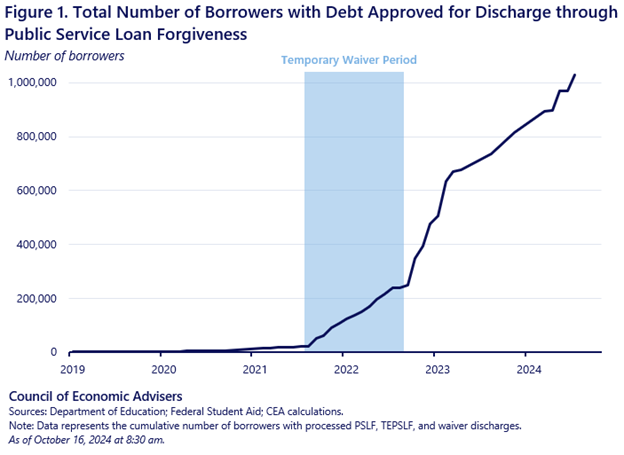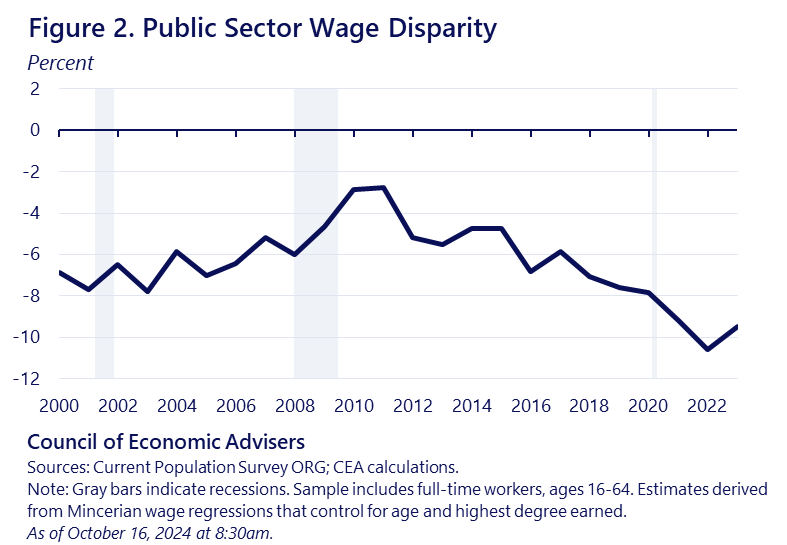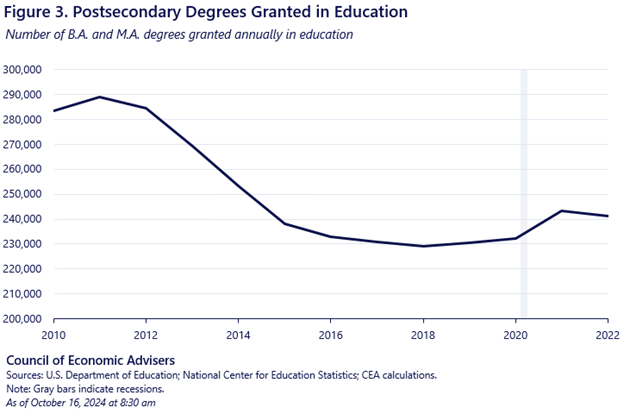Making Public Service Loan Forgiveness Work for Borrowers and the American People
Public servants staff our schools, hospitals, local governments, military, and non-profit organizations, providing essential services to the American people. Given persistent wage differences between comparable jobs in the public and private sectors, Congress created the Public Service Loan Forgiveness (PSLF) program in 2007 through the passage of the College Cost Reduction and Access Act. PSLF allows for outstanding federal student loan balances to be forgiven for public service workers who have completed 10 years of full-time service and made qualifying monthly payments on their loans for 120 months. As we detail in this blog, PSLF makes it financially feasible for students with post-secondary debt to pursue public service careers which play a vital role in our communities and our economy.
Initially, a complex application process, uncertainty around eligibility requirements, data inaccuracies, and servicer mismanagement prevented the vast majority of borrowers seeking PSLF forgiveness from being approved. Before President Biden and Vice President Harris took office, less than 7,000 borrowers were approved for PSLF—fewer than 3% of total applicants. In October 2021, the Biden-Harris administration made significant improvements to the program by 1) granting temporary waivers to provide borrowers the opportunity to receive credit for past periods of repayment, 2) improving the process to certify employment, 3) rewriting program regulations to simplify eligibility requirements and make it easier for borrowers to rightfully earn credit, and 4) simplifying the application process with electronic signatures, the PSLF Help Tool, and payment count information on StudentAid.Gov. These actions made today’s milestone possible: as of October 2024, over 1 million public service workers have had their debt discharged via PSLF and Temporary Extended PSLF (Figure 1). In total, PSLF has provided over $73.7 billion in debt relief to support these essential workers.

A previous CEA issue brief highlights that loan forgiveness can confer considerable benefits on those who receive it – including increased ability to buy a home or start a business, and improved overall financial health. In addition to these general benefits, the PSLF program is designed to serve a more specific role in our economy by addressing a classic market failure: the under provision of public services and the undersupply of public service workers.
The undersupply of public service workers
The work of public servants has broad-based benefits for society that are not reflected in their market wages. Often, these individuals forgo higher salaries in the private sector to serve their communities and their country. Data on the programs of study among individuals who hold federal student loans suggests that nurses, medical assistants, law-enforcement officers, teachers, and social workers comprise the largest public service occupations among debt holders. Many of these jobs demand postsecondary degrees but do not compensate employees on par with their earning potential in the private market. Between 2000 and 2023, public sector workers earned an average of 93.4 cents for every dollar paid to private sector workers of similar ages and educational attainment. As shown in Figure 2, the public sector wage disparity has grown even larger in recent years, increasing from 2.8% in 2011 to 9.5% in 2023. This average masks even larger wage disparities for certain public sector professions. For example, the wage disparity for teachers was as large as 28.7% in 2022 compared to all other full-time workers after accounting for age and educational attainment.

The consequences of the rising wage disparities associated with public service jobs are further exacerbated by the rising costs of higher education. This combination makes it less financially viable to pursue public service and contributes to a tightened labor market for essential public service jobs. In teaching, for example, the annual number of B.A. and M.A. education degree completers fell by 19% between 2007 and 2018, but has begun to rebound in recent years (Figure 3). Still, today at least 10% of K-12 public school teaching positions are either vacant or staffed by underqualified teachers (e.g. emergency credentials; out-of-field teachers).

When too few people enter into public service positions, society as a whole suffers. In the education sector, lower wages lead to higher teacher turnover, imposing hiring and training costs as well as negative impacts on learning. Many communities struggle to staff their fire departments, causing them to rely on volunteers and leading to longer response times. Shortages in the healthcare workforce have resulted in limited access and longer wait times for medical appointments. Currently, 123 million Americans are living in areas with a shortage of mental healthcare professionals and 76 million people have insufficient access to a primary care physician.
PSLF can strengthen our public service sector in two primary ways:
First, the increased accessibility of PSLF has the potential to encourage students to consider public service. Research shows that when students know they will benefit from financial support such as loan forgiveness, they are more willing to enter public service. Expanding the pipeline of future educators, medical professionals, first-responders, and other public sector workers is instrumental in addressing staffing challenges in these professions.
Second, PSLF makes remaining in a public service job more affordable. This is critical given that, for example, 17% of teachers work additional jobs during the school year and 37% currently carry student loan debt. By making public sector jobs like teaching more financially sustainable, PSLF can help reduce turnover. This saves considerable time and money that would otherwise be spent on filling vacant positions. It also benefits students and the general public who are more likely to have access to public sector workers that have accrued considerable skills from their on-the-job experiences.
Conclusion
PSLF is an example of a government program that provides clear benefits to both program beneficiaries and the broader public. The Biden-Harris Administration’s efforts to make the PSLF program work on behalf of the American people have made important contributions to strengthening the public sector of the United States.
